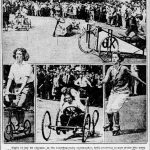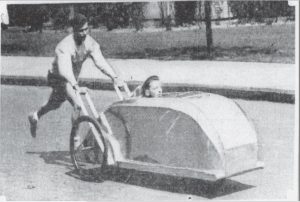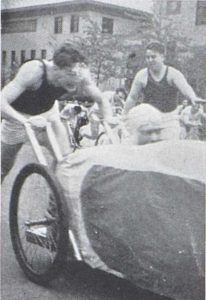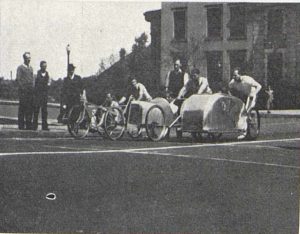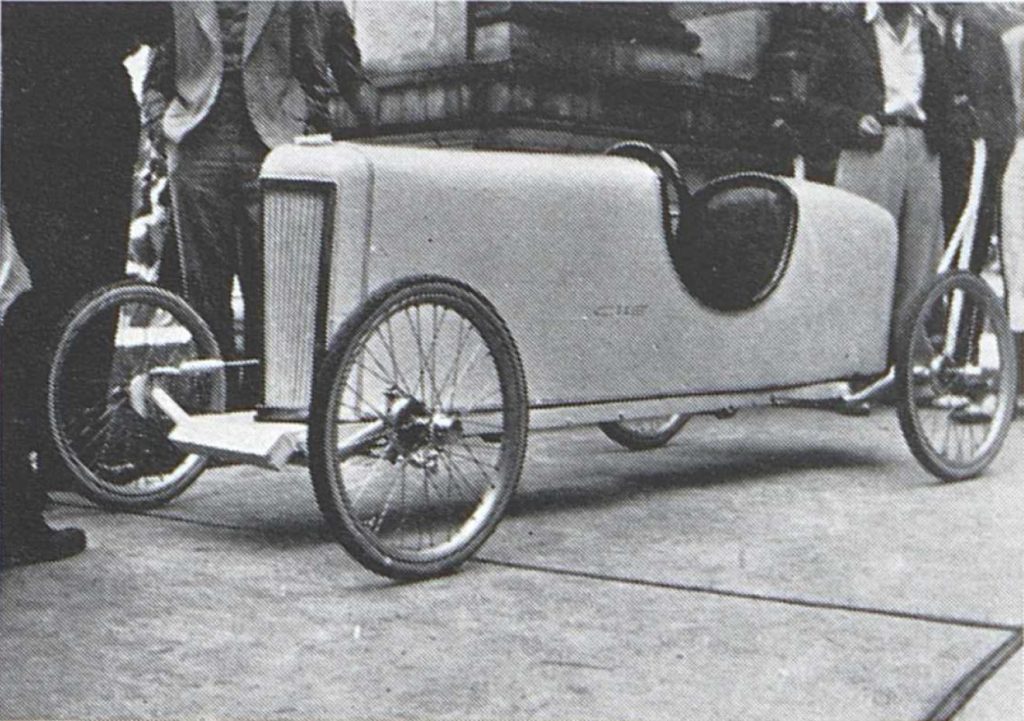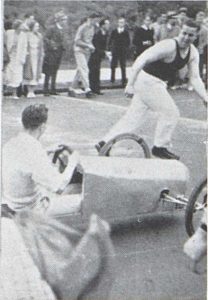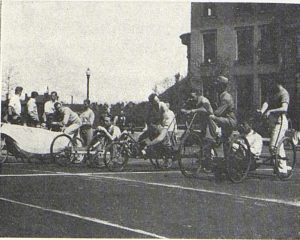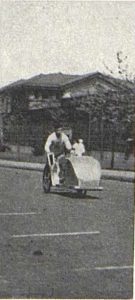Table of Contents: Intro & 1920; 1921-1923; 1924-1927; 1928-1932; 1933-1935; 1936-1939; 1940-1945; 1946-1949; 1950-1953; 1954-1956; 1957-1959; 1960-1963; 1964-1966; 1967-1969; 1970-1973; 1974-1976; 1977-1979; 1980-1983; 1984-1986; 1987-1989; 1990-1993; 1994-1996; 1997-1999; 2000-2003; 2004-2006; 2007-2009; 2010; 2011; 2012; 2013; 2014; 2015; 2016; 2017; 2018; 2019; Recap & 2020
This week, 100 Years of Buggy History dives into the early-mid 1930s. This period was dominated by Beta (and there’s plenty of Beta photos), but we’ve got incidents, DQs, and even sabotage! And did you know that Pitt had buggy races as well?
1933
Raceday: Prelims on Friday, May 12 @ 11:30am; Finals on Saturday, May 13 @ 1:30pm
Sweepstakes Committee: John C. Lightfoot (Chair)
Race Results: (1) Beta (2:48.5 – COURSE RECORD); (2) KapSig; (3) SigNu
Design Comp: (1) Theta Xi; (2) DTD
Weather: Possibly overcast Friday, Rain on Saturday; High of 75/75, Low of 58/64
1933 was all about Beta. Incidents, course records, and a challenge to Pitt. Plus, a rain delay pushed the Finals back.
- Heyday Debut. The Friday of Spring Carnival of 1933 was dubbed “Heyday”, and the Sweepstakes Prelims was one of the main events. Other events included a float parade, tennis matches, and a faculty vs. seniors mushball game.
- Buggy Designs. The early 1920s buggy designs were crude – often, they resembled wooden crates on wheels, rain barrels, and ash cans, and were made out of things like beer kegs or mattress frames. By the late 1920s, they had improved their designs and now resembles race cars of the day. But the first big shift came in the early 1930s. 1930 saw aluminum used for the first time (per the 4/24/2006 Tartan). The first major design breakthrough, however, came with Bill Dilks’ (E’ 36) creation for Beta. The buggy was a 3-wheeler (as discussed last week), but beyond that, it was a wooden framed buggy (per the 4/19/1977 Tartan, though the 4/24/1963 Tartan and others suggest it may have been aluminum) cloaked in airplane silk. This helped to create a lightweight buggy that had more aerodynamic properties. See photos at the bottom of this post for Beta’s 1933 buggy. It is also theorized that this cloth covering of the vehicle is the origin of the term “Buggy”, as the cloth covering resembled the sun-hood of a baby buggy that was prevalent in Pittsburgh at the time.
- Beta’s Buggy Badly Damaged. On May 7, the Sunday before Raceday, Beta was out practicing and crashed their buggy. The driver and pusher, Edward Rhodes and Thomas Ryder (A’33), were injured, with both receiving body bruises and Ryder receiving a head cut. The buggy itself was badly damaged, as the frame was bent and the body, discussed above and made of airplane fabrics, was “torn beyond repair”. According to the Tartan, the accident occurred “at the corner of Beechwood Boulevard near the College of Industries.” However, Beechwood Boulevard doesn’t connect to the College of Industries (now known as Baker/Porter Hall). The description of the incident suggests that the crash may have actually happened in the Chute, as it was described as occurring when the buggy “made a sharp turn while going at full speed.”, though it’s possible it occurred elsewhere in Pittsburgh, as back in the early days of Buggy teams often practiced in off-campus locations to protect secrecy (and because there were no formal practices where roads were closed).
- Beta Races Anyway. It’s unclear whether the Beta buggy that crashed was the same buggy that it won with in 1932, or whether it was a new design. Certainly the “badly damaged” and “torn beyond repair” references in the 5/9/1933 Tartan suggest that it wouldn’t be able to race 5 days later, but it’s also possible that they made a new covering for the buggy and fixed the frame in that time. Whichever is the case, Beta was able to bring a buggy to the course in 1933. KapSig and DTD also had new buggies that would be making their appearance at Raceday. In addition, one fraternity, from the “North” (it’s unclear which one, but fraternities north of campus included ATO, PhiKap, Phi Psi, and PiKA; based on the results we know of and the Pitt fraternities we know existed, our best guess is PhiKap), unfortunately had their buggy totaled when they lent it to a Pitt fraternity for Pitt’s buggy race.
- Heats and Prelim Results. Once again, Prelims in 1933 consisted of 3 Heats with 6 organizations per heat, and the top 2 from each heat moved on to the finals. We don’t know all of the orgs that participated, but the results of each heat were:
- Heat 1: (1) Beta (2:53.2), (2) DTD, (3) ATO – Beta and DTD advance
- Heat 2: (1) Theta Xi (3:05.8), (2) SigNu, (3) PiKA – Theta Xi and SigNu advance
- Heat 3: (1) KapSig (3:01.4), (2) Phi Kappa Psi, (3) Alpha Sig – KapSig and Phi Psi advance
- Rain Delays Finals: Nearly 1 inch of rain fell in Pittsburgh on Saturday, and as a result, Finals (which were initially scheduled for 11am) were delayed until 1:30pm. Beta’s 3-wheeled buggy, which the Tartan called a “frictionless wonder” and “the smoothest thing on wheels around these parts”, cruised to victory in a course record 2:45.8, defeating KapSig and SigNu. Beta’s push team consisted of 3 football players and 2 basketball players: Bradley Edelblut (I’ 34), Hower, Goodrich, Anderson, and Driggin.
- All-Pittsburgh Derby. On Wednesday, May 17, following Beta’s victory on Raceday, Beta issued a challenge to the Pitt chapter of Phi Gamma Delta, who had won the buggy race that took place at Pitt during Pitt Week. PhiGam agreed, provided that they could find 2 wheels to replace those that broke during Pitt’s race. Because of how dangerous Pitt’s course was (see the below tangent), the fraternities agreed to compete on CMU’s course, but since Pitt’s course only required 4 pushers and adding a 5th would put Pitt at a disadvantage, the parties agreed to use 4 pushers. In addition, track runners were eligible to participate, so Tom Coulter (E’33), a member of Beta and the captain of the Track team (and, as a side note, a player on the Chicago Blackhawks for 1 season), was eligible to push (the 3 other pushers would have been chosen from Biggin, Croissant, Hower, Edelblut, Goodridge, and Anderson). This would have been the most exciting Buggy race in Pittsburgh history! Unfortunately, 2 of PhiGam’s pushers were track runners and Pitt’s Varsity Track coach refused to let his team members participate in the race. Therefore, the race was cancelled and we never got to crown an All-Pittsburgh Buggy Champion.
- Off on a Tangent – Other Buggy Races. Did you know that CMU wasn’t the only school to have Buggy races in the Pittsburgh area? Both Pitt and Washington & Jefferson hosted buggy races in the early years. We know almost nothing about W&J’s, other than a refernece in a 4/21/1925 article suggesting that Pitt, CMU, and W&J compete in an intercollegiate race. We know more about Pitt’s races, which continued for quite a while during Pitt Week (I don’t have exactly when it ended, but likely around WWII). And Pitt’s race was DANGEROUS. We don’t know the exact course (it may be available through Pittsburgh news archives, but since this series is focused on CMU’s buggy races, I didn’t pay much attention to Pitt’s), but it took place on Bigelow Blvd and Bayard St. In 1925, 8 of the 16 entrants crashed and piled up on the corner of Bigelow and Bayard, seriously injuring 2 participants and slightly injuring “a score” of spectators. One pusher was knocked unconscious and suffered lacerations to the head and body when his buggy crashed into an already wrecked buggy, and he was then struck by the next buggy coming around the corner. Another student suffered a dislocated jaw. A cameraman for the Post-Gazette was also injured and his camera smashed when he was struck by a Buggy and thrown 10 feet into the air. Here’s some photos from the Post-Gazette, but what I’m really saying is that CMU’s course is WAY better for Buggy than Pitt’s ever was.
1934
Raceday: Prelims on Friday, May 11; Finals on Saturday, May 12
Sweepstakes Committee: Bradley Edelblut (Chair)
Race Results: (1) KapSig (2:49.7 – COURSE RECORD); (2) PiKA; (3) Theta Xi; (4) DTD
Design Comp: (1) Beta; (2) PiKA; (3) Theta Xi
Weather: Possibly overcast on Friday, Sunny Saturday; High of 64/63, Low of 49/39
Beta’s 3-wheeled success spawned some imitators, and one of those found success in 1934. The lack of archives from the year limits our full picture though.
- Small Field? According to the May 11, 1934 Pittsburgh Sun-Telegraph, only 7 fraternities entered buggies. Since this was a Pittsburgh city paper, rather than the Tartan, it’s very possible that this number refers to a subset of entries (maybe it was 7 in one heat, or 7 qualified for finals) rather than the total, since this would be a significant drop-off from 18 in 1933. On the other hand, photos at the bottom of this post from the 1935 Thistle show 7 total buggies, spread out over 2 heats, so it’s possible that the drop-off occurred.
- Trouble Brewing; Rules Recap. To understand the troubles that would befall Beta in 1934, I need to remind you of 2 rule differences that existed in the early days and have previously been mentioned, but play specific roles in 1934.
- The Hill 2 pusher actually travels with the Buggy by riding on it through the freeroll. That pusher then transitions the Buggy to the Hill 3 pusher deep in the Chute (slightly earlier than the present-day start of Hill 3).
- Pusher transitions must occur within the transition zone – the first pusher must be touching the Buggy when it enters the zone, and the second pusher must be touching the Buggy as it leaves the zone.
- Beta’s No-Good-Very-Bad-Day. In 1934, Beta was cruising along in their heat and getting ready to threepeat as champion. They entered the chute leading by about 50 yards. As they began to transition from Hill 2 to Hill 3 (through the Chute), Beta’s buggy was moving particularly fast. The Hill 2 pusher pushed off, but the buggy was travelling too fast for the Hill 3 pusher. He made a desperate attempt to catch up, but stumbled and fell, and the buggy crossed the end of the transition zone without a pusher (can you imagine if that were still a rule today!). In fact, it took so long for the pusher to get up that the buggy had actually come to a stop and started to roll back towards the chute. The pusher eventually caught up to it and Beta easily crossed the finish line first, with a time of 2:54 that put it in first place after the Prelims (4 seconds in front of 2nd place), but they were DQ’d for a transition zone violation.
- KapSig’s KopyKat. KapSig saw Beta’s success with a 3-wheeled design and, in true buggy fashion, decided to make one of their own. It was a brilliant decision, and that new design, combined with fast pushers and the DQ of Beta, led them to a course record 2:49.7, earning their first win since the final Campus Week in 1928.
- Beta Gets Redemption at Design. It may have been DQ’d in the race, but Beta’s buggy was good enough to take home the Design Comp trophy, snapping Theta Xi’s 4-year winning streak. See photo right for Beta’s design-winning Buggy, which we believe was the same buggy as the previous 2 years, but with a new aluminum cover, rather than the prior airplane silk.
1935
Raceday: Prelims on Friday, May 10 @ 11am; Finals on Saturday, May 11 @ 11am
Sweepstakes Committee: Unknown
Race Results: (1) Beta (2:47.2 – COURSE RECORD); (2) KapSig
Design Comp: (1) Theta Xi; (2) PiKA; (3) Beta
Weather: Possible rain on Friday; Sunny on Saturday; High of 72/71, Low of 56/49
There were 2 big stories in 1935; the final crowning of Beta (before KapSig would begin their reign of terror in the pre-WWII era), and SABOTAGE.
- Staggered Lanes. Due to the traffic dummies on Tech Street, teams in the outside lanes (think Lane 3) were at a disadvantage as they were forced to go wide to avoid the dummies. Therefore, Sweepstakes instituted a staggered start and gave those teams a 3 yard advantage. Buggies were required to stay in their lane until they passed the second dummy at the top of Hill 2.
- 3-Wheelers Are The Future. This is the first time in several years that the Tartan printed the official Sweepstakes rules. So we don’t know exactly when the 4-wheel rule changed (other than Beta rolling a 3-wheeler in 1932), but by 1935 the rules officially required no fewer than 3 and no more than 5 wheels on a Buggy. Other formalized rules included that the pusher must be touching the Buggy at all times, except in the transition zones (and the transition zones are 10 yards wide), and that all Design Comp entries were required to race.
- Previewing the Top Contenders. 1935 was expected to be a 3-team race. The May 7 Tartan noted that the battle was between Beta, KapSig, and DTD. Beta’s buggy resembled a polished “bullet-shaped bathtub” (see the photo from 1934 above), while DTD debuted “knee action wheels, the latest in pushmobile designs”.
- PiKA Builds. Courtesy of the Pi Kappa Alpha archives of their national newsletter, the Shield & Diamond, we actually know a little bit about their 1935 buggy! Brothers Wallis Hamilton and Roy Minet put together the new design, which consisted of “individual wheel suspension, a chrome-molybdenum frame, bronze bushings, chromium sulky wheels, an underslung body barely clearing the ground, and bearings equipped throughout.”
- The First (But Not Last) Attempted Course Sabotage. Many Buggy fans know about the great “oil slick” controversy of 1985 (and if you don’t, have no fear…we’ll get there!). But what you may not know is that the 1985 incident was merely honoring the 50th anniversary of the first attempted sabotage of the Buggy course! Prior to the race (whether it was Prelims or Finals is never specifically mentioned, but from context, it was likely the Finals), someone dumped a bucket of sand in the Chute. The purpose of the sand was reportedly to cause the first Buggy to reach the Chute to skid and flip over, potentially injuring the driver and pusher of the leading Buggy. The Tartan hints that the intended target of this sabotage was Beta. Luckily, the sand was discovered and cleared before the race began, so it didn’t ultimately affect the race.
- Race Results. The rules stated that the race would be run in 3 heats, with the top 2 teams from each heat advancing to Finals. However, we only know of the results of 2 Prelim heats, so it’s unclear if 3 actually ran or it decreased to 2. In the first, PiKA was victorious and DTD finished in 2nd, though the time of the heat was considered “rather slow”. In the second heat, Beta easily defeated KapSig by a wide margin, with those two advancing to the Finals. In the Finals, Beta took the lead up the front hills and entered the Chute well in front. But they lost some of their speed at the Chute-Hill 3 transition and KapSig quickly gained on Hill 3. Beta held on through the final 2 Hills and was able to narrowly nose out the late charge of KapSig in what the Tartan (incorrectly?) referred to as a “Garrison Finish“, setting a course record of 2:47.2.
Next week, we’ll cover the rest of the 1930s, but a warning in advance – We are missing digital archives of the Tartan from 1936-1939, so information about these years is pretty limited (particularly 1937, our current White Whale, where we only have a (very) educated guess of who actually won), so if YOU know any information about these years, let us know! On the plus side…we do have plenty of scanned photos!


